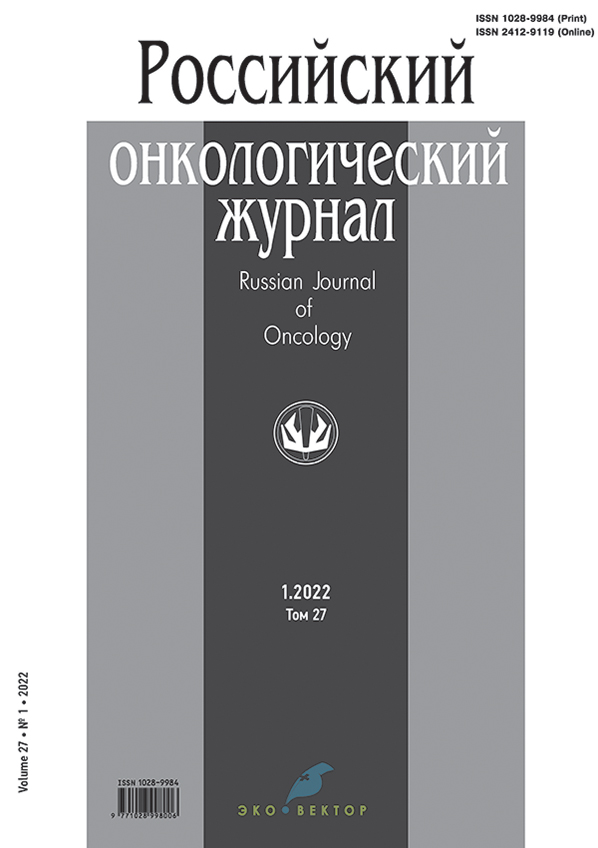Vol 27, No 1 (2022)
Original Study Articles
MiR-155-5p-mediated increase in p53 content induced by dacarbazine in melanoma cells
Abstract
BACKGROUND: Cellular senescence is a stress response, triggered by various stimuli such as chemotherapy treatment and causes G0/G1 cell cycle arrest followed by the production of a senescence associated secretory phenotype. p53 considered to be a modulator of these events although the precise mechanisms of it remains not clear.
AIMS: To determine the non-apoptotic functions of the p53 protein — the formation of the senescence associated secretory phenotype phenotype of melanoma cells under the treatment of the cytostatic agent dacarbazine.
MATERIALS AND METHODS: The study was conducted on BRO and SK-MEL-2 skin melanoma cell lines. Melanoma cells were were treated by cytostatic agent dacarbazine. Then immunocytochemical study was performed to determine the proportion of G0-positive cells and the expression of the tumor suppressor protein p53. A bioinformatic analysis was accomplished to identify for p53 regulators with determining of miR-155-5p levels in exosomes released by dacarbazine-treated melanoma cells.
RESULTS: The cytostatic drug dacarbazine increases the proportion of cells residing in the G0 phase of the cell cycle. Onco-microRNA miR-155-5p was expressed in the exosomes of the two studied cell lines BRO and SK-MEL-2 of skin melanoma. Changes in the expression level of p53 correlate with changes in miR-155-5p microRNA expression. The absence of changes in p53 expression in BRO melanoma cells may be due to the absence of changes in miR-155-5p expression levels. In the BRO cell line, no changes in the expression of the oncosuppressor p53 were observed with an increased percentage of G0-positive cells, which may be associated with the activation of other mechanisms of cell cycle arrest in the G0/G1 phase.
CONCLUSIONS: Heterogeneous effect of the cytostatic agent dacarbazine on melanoma cells was revealed. For the SK-MEL-2 cell line, dacarbazine induces the release of senescence associated secretory phenotype by inhibiting exosomal production of miR-155-5p, which activates the p53 oncosuppressor, which was not observed in the BRO line.
 21-28
21-28


Reviews
The role of mitochondria in the development of breast cancer
Abstract
There is a hypothesis that mitochondrial dysfunction and mutations in the mitochondrial genome may play an important role in the carcinogenesis; however, despite many years of research, this issue is still the subject of scientific discussion. The review reflects modern views on the role of mitochondria and the mitochondrial genome in the development of breast cancer. Sources were searched in Pubmed and eLIBRARY.RU databases for the past 10 years and in article references. Articles were selected that contained data from case-control studies of breast cancer and studies of cybrid cells.
The survey of experimental and association studies has shown that the mitochondrial genome determines the characteristics of cellular metabolism in human populations at the global (by macrohaplogroups L, M, N), landscape (by haplogroups), population (by subhaplogroups), and individual levels (by SNPs, insertions, deletions) and can determine predisposition to cancer. Single nucleotide substitutions, deletions, and mitochondrial DNA copy number decline are not specific for breast cancer. Nevertheless, mitochondria have been experimentally shown to be directly involved in the development of malignant neoplasms in experimental animals. It is likely that mitochondrial involvement in carcinogenesis is associated with mitochondrial dysfunction, in which nuclear-mitochondrial relationships are disrupted. On the other hand, mutations with too strong effect, i.e., completely disrupting mitochondrial function, lose their tumorigenic potential. Mutations, deletions and changes in mitochondrial DNA copy number are undoubtedly associated with the development of breast cancer, being one of the most important elements of a complex web of numerous interactions.
 5-19
5-19


Case Reports
Rare clinical case of diffuse B-large cell lymphoma with laryngeal lesion
Abstract
Diffuse large B-cell lymphoma (DLBCL) is the most common variant of non-Hodgkin’s lymphoma and accounts for 30–60% of all non-Hodgkin’s lymphomas, with increasing incidence increases with age. Currently, the prognosis is assessed using the International Prognostic Index. In recent years, in all European regions, there has been a significant improvement in survival in DLBCL due to the addition of rituximab to standard chemotherapy (CHOP protocol). However, despite significant advances in treatment, long-term remission is only achieved in half of the patients. Laryngeal lesions with this variant of lymphomas is described only in a few articles. There is evidence of various chemotherapeutic regimens effective in this type of lymphoma; in some publications, the authors suggest the use of radiation therapy.
The article presents a clinical case of successful treatment of a patient (chemotherapy + radiation therapy) with diffuse large B-cell lymphoma with laryngeal involvement. with resulting remission. In addition, a review of the literature describing the most common types of lymphomas is presented. The authors set a goal to raise the awareness of physicians about a rare histological variant of laryngeal tumors with a rapid increase in clinical manifestations and the development of life-threatening conditions.
 29-36
29-36


Editorials
Anniversary: Alexander Lazarev
Abstract
Alexander Fedorovich Lazarev, since 1980, has been actively engaged in teaching activities as an assistant, and after defending his doctoral dissertation, as a professor at the Department of Oncology of the Altai State Medical University. From 2000 to the present, Professor A.F. Lazarev — Head of the Department of Oncology, Radiation Therapy and Radiation Diagnostics with the FVE course of the Federal State Budgetary Educational Institution of Higher Education “Altai State Medical University” of the Ministry of Health of the Russian Federation. A.F. Lazarev is the editor-in-chief of the Russian Journal of Oncology, Moscow (2012), a member of the editorial boards of the journal Issues of Oncology, Eurasian Journal of Oncology, Russian Journal of Biotherapy. Professor A.F. Lazarev — the author of 70 monographs and collections of scientific papers, has more than 2500 scientific articles and publications, 67 students finished candidate and doctoral dissertations under his supervision.
 37-40
37-40












